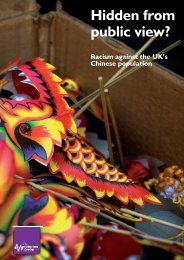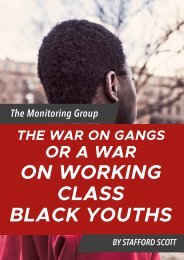Coming of Age : 1976 and the Road to Anti-Racism
Coming of Age : 1976 and the Road to Anti-Racism by Jagdish Patel and Suresh Grover
Coming of Age : 1976 and the Road to Anti-Racism
by Jagdish Patel and Suresh Grover
You also want an ePaper? Increase the reach of your titles
YUMPU automatically turns print PDFs into web optimized ePapers that Google loves.
It has led <strong>to</strong> <strong>the</strong> conclusion that: ‘Carnival is a cultural institution which regularises<br />
<strong>and</strong> ritualises <strong>the</strong> permanent social conflict. It is a .. . form <strong>of</strong> class struggle. It enables <strong>the</strong><br />
underprivileged class <strong>to</strong> make revolution without really performing it, <strong>and</strong> <strong>to</strong> improve its<br />
social position again <strong>and</strong> again for a short period <strong>of</strong> time without even <strong>to</strong>uching <strong>the</strong> society’s<br />
existing power structure’.’<br />
But this is not <strong>the</strong> whole s<strong>to</strong>ry. Class struggle cannot always be ritualised. There are<br />
situations in which <strong>the</strong> existing structures <strong>of</strong> power, class or wealth are unstable; are <strong>the</strong><br />
object <strong>of</strong> quests for fundamental change. One such is <strong>the</strong> colonial situation. For example<br />
under British colonialism in Trinidad in <strong>the</strong> Caribbean <strong>the</strong> Carnival broke <strong>the</strong> bounds <strong>of</strong> ritual.<br />
This was certainly so after slavery. The colonial order was <strong>to</strong>o nervous <strong>to</strong> allow itself <strong>to</strong> be<br />
mocked. The danger that <strong>the</strong> masses (African <strong>and</strong> later African <strong>and</strong> Asian) might shift from<br />
mock <strong>to</strong> real rebellion was perceived as ‘a clear <strong>and</strong> present danger’. In <strong>the</strong> face <strong>of</strong> this<br />
fear suppression was attempted <strong>and</strong> this brought forth vigorous resistance from <strong>the</strong> people<br />
in defence <strong>of</strong> what <strong>the</strong>y knew <strong>to</strong> be legitimate culture <strong>and</strong> against illegitimate (white,<br />
colonial) authority. And within <strong>the</strong> United Kingdom itself, well before football became a main<br />
focus <strong>of</strong> working class cultural expression, well before <strong>the</strong> sway <strong>of</strong> <strong>the</strong> music hall, <strong>the</strong>re were<br />
what have come <strong>to</strong> be called <strong>the</strong> metropolitan fairs.<br />
The growth <strong>of</strong> <strong>the</strong> Carnival<br />
The Notting Hill Carnival is still with us. Alive, <strong>and</strong> on <strong>the</strong> streets <strong>of</strong> <strong>the</strong> Royal Borough<br />
<strong>of</strong> Kensing<strong>to</strong>n <strong>and</strong> Chelsea, London. It made its first appearance <strong>the</strong>re in 1966. It is largely<br />
agreed that its founding spirit was a white social worker, Mrs Las- lette. The aim was <strong>to</strong> create<br />
a ‘West Indian’ carnival in this area <strong>of</strong> major black settlement in <strong>the</strong> UK. The model was<br />
<strong>the</strong> Eastern Caribbean <strong>and</strong> Trinidad in particular. But this was not <strong>the</strong> only model available.<br />
English people were not, after all, unfamiliar with <strong>the</strong> notion <strong>of</strong> ‘carnival’. Even in terms <strong>of</strong><br />
<strong>the</strong> local his<strong>to</strong>ry <strong>of</strong> North Kensing<strong>to</strong>n <strong>the</strong>re appears <strong>to</strong> have existed an idea <strong>of</strong> carnival as<br />
an ‘olde’ English celebration.<br />
Thus <strong>the</strong> main local newspaper <strong>of</strong> <strong>the</strong> period, <strong>the</strong> Kensing<strong>to</strong>n News <strong>and</strong> West London<br />
Times, contains references <strong>to</strong> ‘carnivals’ in <strong>the</strong> area before 1966. The model_was last dusted<br />
<strong>of</strong>f <strong>and</strong> used as recently as <strong>the</strong> present Queen’s silver jubilee. In any event elements <strong>of</strong><br />
this ‘English’ idea <strong>of</strong> carnival were paraded at <strong>the</strong> first carnival in 1966.<br />
In <strong>the</strong> first eight years <strong>of</strong> its existence <strong>the</strong> Notting Hill carnival grew very slowly. Essentially<br />
it was small <strong>and</strong> run largely by people from <strong>the</strong> West Indies. The conflicts which appeared<br />
in those years were between West Indian individuals for control <strong>of</strong> <strong>the</strong> management <strong>of</strong> <strong>the</strong><br />
event. Culturally its main contents were <strong>the</strong> music <strong>of</strong> <strong>the</strong> Trinidad originated steel b<strong>and</strong>,<br />
168 | <strong>Coming</strong> <strong>of</strong> <strong>Age</strong><br />
<strong>Coming</strong> <strong>of</strong> <strong>Age</strong> Final version 16.10.indd 168 17/10/2017 12:08







